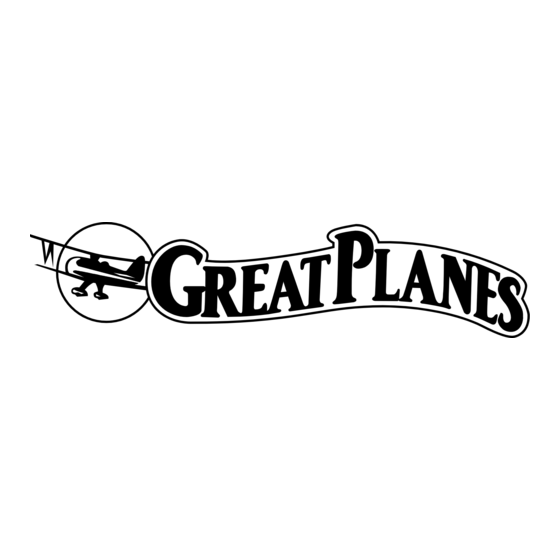GREAT PLANES J-3 ElectriCub Руководство по эксплуатации - Страница 16
Просмотреть онлайн или скачать pdf Руководство по эксплуатации для Игрушка GREAT PLANES J-3 ElectriCub. GREAT PLANES J-3 ElectriCub 20 страниц. Electric sport-scale arf

IMPORTANT! Flying a model with too few rubber bands
can be dangerous. If the wing momentarily lifts from the
fuselage and acts as though a large amount of "up"
elevator has suddenly been applied because there are
not enough rubber bands or they are too weak, internal
structural damage may result. Even worse, the wing could
actually detach from the fuselage resulting in a crash. If
the model exhibits any tendencies that indicate there are
not enough rubber bands, immediately reduce power,
land and closely inspect the model for damage. If no
damage is found, add more rubber bands.
The Mini Cub ARF is a great-flying model that flies smoothly
and predictably. The Mini Cub ARF does not, however,
possess the self-recovery characteristics of a primary R/C
trainer and should be flown only by experienced R/C pilots.
CAUTION (THIS APPLIES TO ALL R/C AIRPLANES): If,
while flying, you notice an alarming or unusual sound
such as a low-pitched "buzz," this may indicate control
surface flutter . Flutter occurs when a control surface
(such as an aileron or elevator) or a flying surface (such
as a wing or stab) rapidly vibrates up and down (thus
causing the noise). In extreme cases, if not detected
immediately, flutter can actually cause the control surface
to detach or the flying surface to fail, thus causing loss of
control followed by an impending crash. The best thing to
do when flutter is detected is to slow the model
immediately by reducing power, then land as soon as
safely possible. Identify which surface fluttered (so the
problem may be resolved) by checking all the servo
grommets for deterioration or signs of vibration. Make
certain all pushrod linkages are secure and free of play. If
it fluttered once, under similar circumstances it will
probably flutter again unless the problem is fixed. Some
things which can cause flutter are; Excessive hinge gap;
Not mounting control horns solidly; Poor fit of clevis pin in
horn; Side-play of wire pushrods caused by large bends;
Excessive free play in servo gears; Insecure servo
mounting; and one of the most prevalent causes of flutter;
Flying an over-powered model at excessive speeds.
MOTOR SAFETY PRECAUTIONS
Failure to follow these safety precautions may result
in severe injury to yourself and others.
1. Do not run the motor in an area of loose gravel or sand;
the propeller may throw such material in your face or eyes.
2. Keep your face and body as well as all spectators away
from the plane of rotation of the propeller at all times that the
motor is armed.
3. Keep these items away from the prop: loose clothing, shirt
sleeves, ties, scarves, long hair or loose objects such as
pencils or screwdrivers that may fall out of shirt or jacket
pockets into the prop.
4. The motor gets hot! So does the battery pack and the
ESC. Do not touch it during or right after operation.
5. REMEMBER! This is an electric motor. Unlike a glow
engine, it can start at any time without any movement of the
prop by the user. ALWAYS take extreme care around your
electric motor.
6. Do not use hands, fingers, or any other body part to try
and stop the motor. Do not throw anything into the propeller
of a running motor.
AMA SAFETY CODE (excerpt)
Read and abide by the following excerpts from the Academy
of Model Aeronautics Safety Code. For the complete Safety
Code refer to Model Aviation magazine, the AMA web site
or the Code that came with your AMA license.
GENERAL
1) I will not fly my model aircraft in sanctioned events, air
shows, or model flying demonstrations until it has been
proven to be airworthy by having been previously,
successfully flight tested.
2) I will not fly my model aircraft higher than approximately
400 feet within 3 miles of an airport without notifying the
airport operator. I will give right-of-way to and avoid flying in
the proximity of full-scale aircraft. Where necessary, an
observer shall be utilized to supervise flying to avoid having
models fly in the proximity of full-scale aircraft.
3) Where established, I will abide by the safety rules for the
flying site I use, and I will not willfully and deliberately fly my
model in a careless, reckless and/or dangerous manner.
5) I will not fly my model unless it is identified with my name
and address or AMA number, on or in the model. Note: This
does not apply to models while being flown indoors.
7) I will not operate models with pyrotechnics (any device
that explodes, burns, or propels a projectile of any kind).
RADIO CONTROL
1) I will have completed a successful radio equipment ground
check before the first flight of a new or repaired model.
2) I will not fly my model aircraft in the presence of
spectators until I become a qualified flier, unless assisted by
an experienced helper.
3) At all flying sites a straight or curved line(s) must be
established in front of which all flying takes place with the
16
